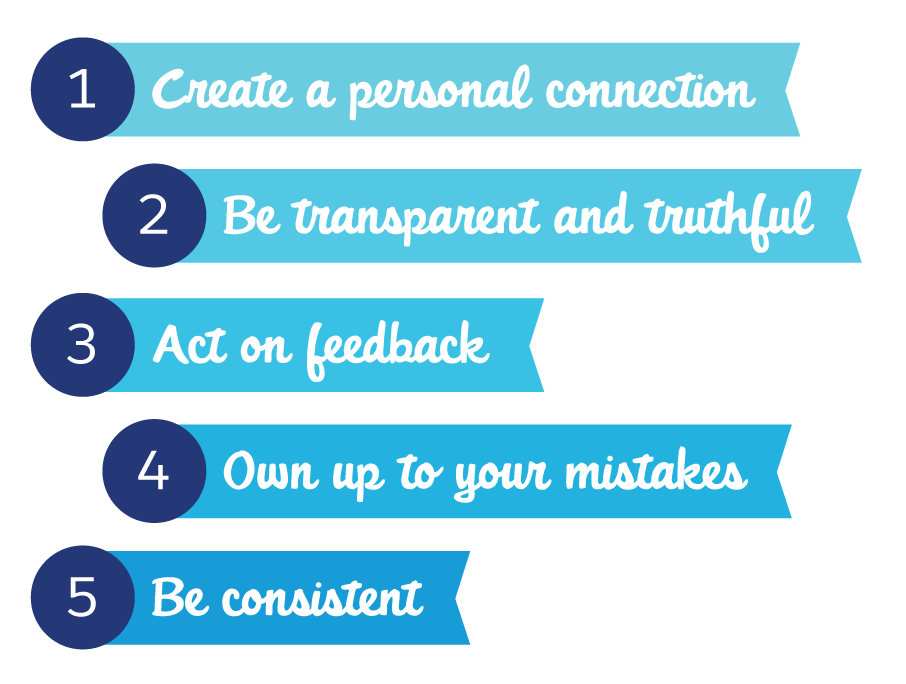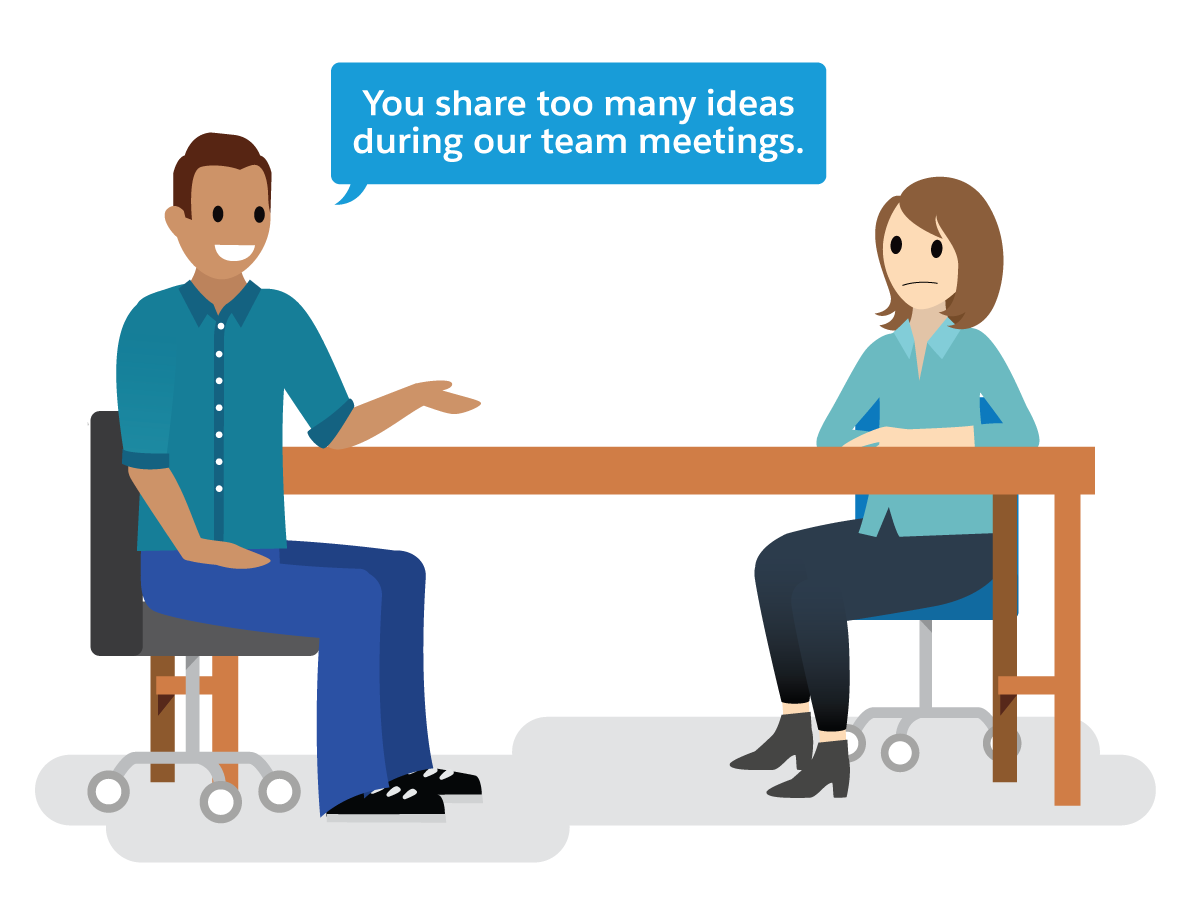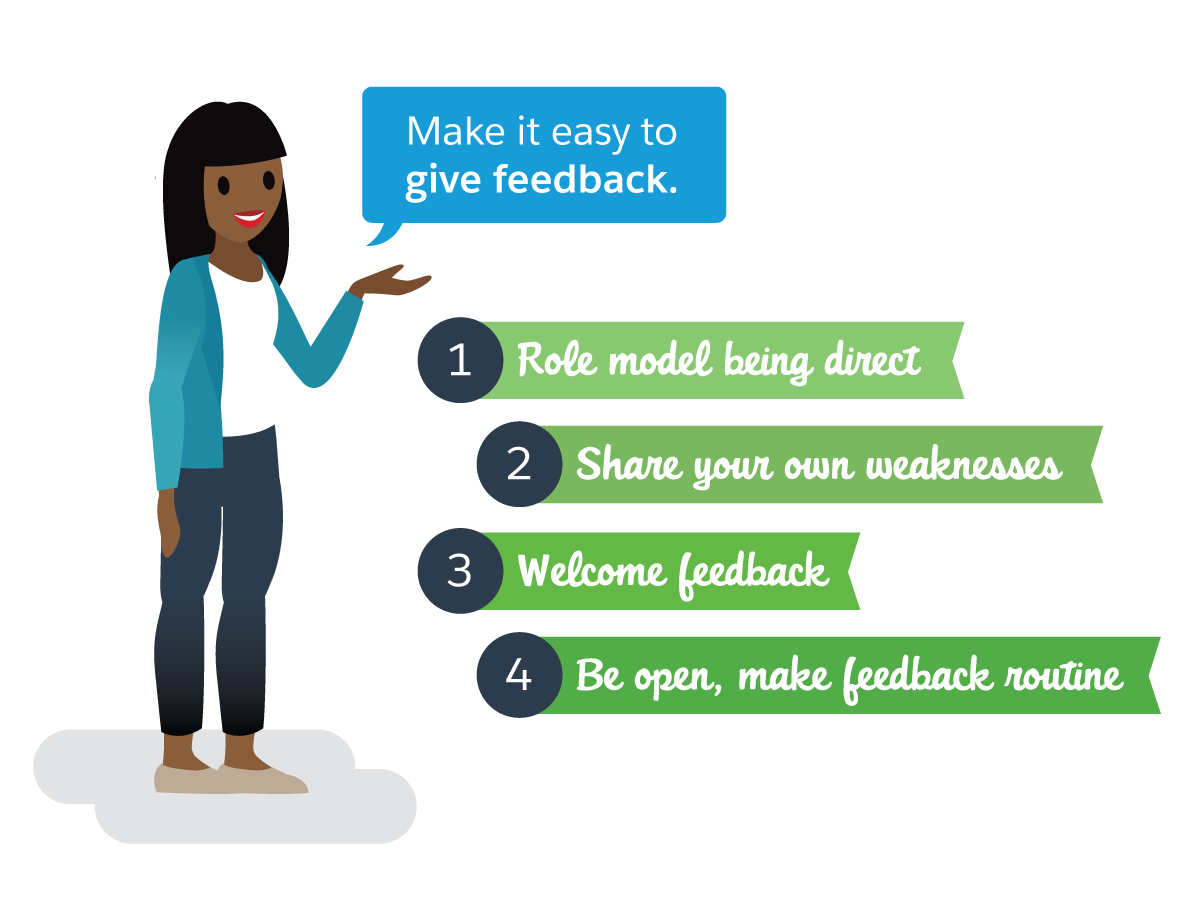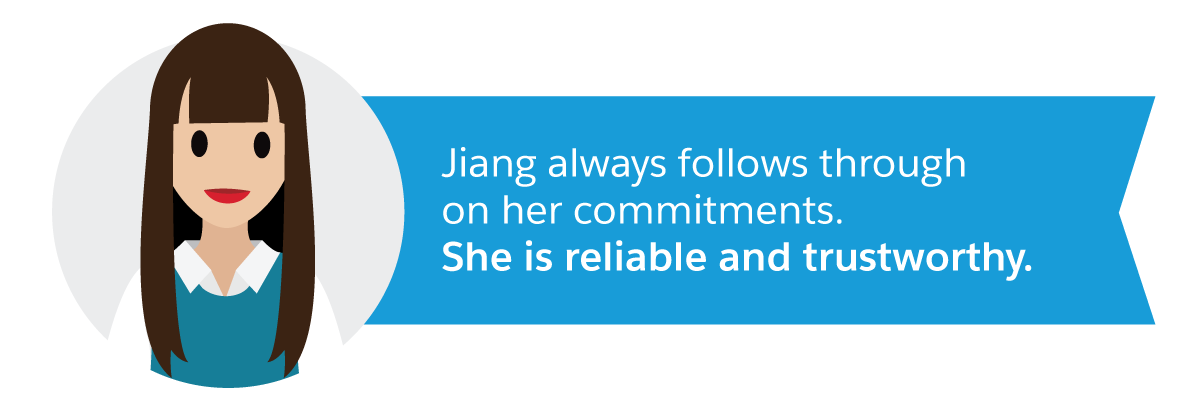Develop Trusted Relationships
Learning Objectives
After completing this unit, you’ll be able to:
- Identify the importance of trust to your business.
- Consider how well you are building trust on your team.
- Use techniques to build and maintain trust over time.
Understand the Business Value of Trust
Trust is our number one value at Salesforce. And it’s not just a “feel good” sentiment.
We are serious about creating and maintaining trusted connections with our customers, communicating transparently, and engaging intelligently with technology in order to keep their data secure. We’ve worked hard to build a foundation of trust with our customers, and it’s our job to protect that trust at all times.
We also empower our employees to voice their ideas and opinions in order to drive change within our company, industry, and communities. Like our Great Characteristic “Win as a Team,” we see trust as key to building relationships, collaborating, working cross functionally, and influencing others.
Of course Salesforce is not alone in valuing trust as a key to success. Many other companies have seen how trust impacts the bottom line. According to a study on workplace trust by the Human Capital Institute and Interaction Associates trust drives:
- Employee engagement, learning and development, and productivity
- Teamwork and collaboration
- Risk taking and innovation
- Customer loyalty and retention
- Business results and profit growth

So what happens if there isn’t trust? Employees may put in less effort, feel apathetic toward their jobs, or even leave the organization. If they don’t leave, they may “quit and stay” and negatively impact morale and productivity. None of that is good.
 You’re probably wondering, how well is my company doing on trust? And how can I build and maintain trust with my employees? Good questions. Tips and strategies lie ahead!
You’re probably wondering, how well is my company doing on trust? And how can I build and maintain trust with my employees? Good questions. Tips and strategies lie ahead!
Evaluate How Well You Are Trusted
How do companies evaluate trust in their organizations?
Most companies have a way to measure customer trust through surveys and data analysis. Companies also evaluate employee trust through employee surveys that ask questions about:
- vision and strategy
- communication and transparency
- how often team members ask each other for help
- openness of leaders to ideas and suggestions
- how well leaders admit mistakes
- confidence in senior leadership
It’s one thing to know how well your company is doing. It’s another to make a personal commitment to building trust on your team.

You might say to yourself “Oh, I'm sure my team trusts me.” Perhaps, but did you know that when asked, “Do you trust your boss?” half of employees in the Interaction Associates study said, “No.” Yikes!
Take the Trust Self-Assessment within the Trust & Influence pack to find out how well you’re building trust with your team.
How did you do on the self-assessment? If you didn’t do as well as you had hoped, consider asking yourself:
- Do I get to know each of my team members personally?
- How honest am I when I communicate? What about the tough stuff?
- Do I openly admit when I make mistakes?
- Do I ask my team members for feedback and act on it?
- Do I follow through on what I’ll say I’ll do?
If you answered yes to most of these questions you’re well on your way!
Build and Maintain Trust
Building trust isn’t something you do overnight. Every interaction with each team member is an opportunity to build and maintain trust. Do it well and trust goes up. Stumble, and trust erodes.
Somebody once said, “I always feel like somebody’s watching me. Who’s playing tricks on me?” Well, no one, actually. But your team is watching you. They pay attention, both to what you do and what you say. That's why as leaders, we've got to walk the walk and talk the talk.
Here are five ways to build trust:

Let’s take a look at each!


1. Create a Personal Connection.
Marion knows her team members well. She takes time in her one-on-one meetings to get to know each person better. She gives them a chance to open up to her and really listens. Her favorite way to have a one-on-one meeting is to go outside or have a coffee, which makes it much easier to talk about things other than work.
When your employees know you as a person, and you take the time to ask them about themselves, you’ll build trust. They’ll know that you care about them. Get to know people and let them get to know you.


2. Be Transparent and Truthful.
Tien’s team says she’s a great communicator and that contributes a lot to how much they trust her. She shares what she can about company performance, changes in the team, direction, and priorities. She is direct and transparent and always shares what she can while remaining positive, even when the message is tough. She’s open to questions and challenges. Tien knows that if she doesn’t share what she can, her team will make assumptions or make up stories about what’s going on.
Tien’s philosophy about communication is:
- Communicate frequently, even if it means sharing the same message several times.
- Share what you can when you can. It’s okay to say “I don’t know,” but add “when I can share more I will.”
- Be fearless and tell the truth, even if you are bearing bad news.
- Ask for questions and concerns, and listen and respond.
- Don’t punish people for raising issues (don’t “shoot the messenger”).
- Ask people for their input on decisions that impact them.

3. Act on Feedback.
Grace’s team feels really comfortable giving her feedback. She’s shown them time and time again that she takes their feedback seriously. So seriously, that when the feedback is valid and on the mark, they see her act on it immediately.

One time, one of her directs, Raul, told her she sometimes shares too many ideas during team meetings. This sometimes led the team to feel overwhelmed, stressed, and confused about priorities. Grace thanked Raul and immediately started clarifying priorities and letting the team know when an idea was just an idea, and not something they had to drop everything to get done. The team saw a difference right away.
The starting point is asking for feedback. Of course, it takes courage for your direct reports to give you candid feedback. After all, you’re the boss.

You may be wondering, what’s the best way to make my team feel safe to give me feedback? For one, you can proactively ask your employees for feedback—in your one-on-one’s and team meetings.
And second, when the feedback is consistent with either what you’ve been told before, or what you’ve noticed about yourself, act on it! When you respond to feedback, your employees will know that you value what they say, and they’ll continue to give you feedback in the future.
What does it look like to act on feedback? When you act on feedback, you:
- Identify specific behaviors that you’ll start, stop, or continue doing
- Ask your team members and/or manager to observe what you are doing and give you feedback
- Monitor your progress and make adjustments as needed


4. Own up to your Mistakes.
Tom messed up. He was harsh towards Keisha in the meeting and gave her feedback in front of everyone. He was impatient and said a few things that were really rude. As he sat in his office after the meeting, he felt really embarrassed. What to do? Just let it go and hope that the team was okay or say something about it?
Tom knew the answer. He knew that the team would think less of him if he didn’t admit when he did something wrong. He brought the whole team into his office and apologized for his tone in front of everyone. This went a long way toward the team respecting and trusting Tom.
Making yourself vulnerable by admitting mistakes is a powerful way to build trust.
Being vulnerable means:
- having the courage to tell others when you’ve made a mistake
- apologizing, and taking ownership and accountability for it, if appropriate
- communicating what you’ve learned from the mistake
When you own up to your mistakes, you demonstrate to others that they can do the same. While it takes courage, and swallowing some pride, the trust you build with your team makes it well worth it.
In fact, showing vulnerability makes you a better leader. It shows you are human just like everyone else. Role modeling vulnerability by asking for input, admitting mistakes, and sharing what you’ve learned sets the tone for building trust for your team.
And finally, 5. Be Consistent



- Jiang promised the team she’d share product information by the next team meeting, so they'd be ready to help customers
- She brought the information to the team on time
- She exceeded expectations by bringing someone from the product team along to the team meeting to answer questions

- Marco sent a message to the SVP of the group to recognize the great job his direct report Elizabeth did on a tough customer renewal
- He sent a similar message for another direct report last month to highlight an achievement
- He consistently recognizes everyone for their accomplishments, making sure no one gets, or is perceived as receiving, special treatment

- Last month, when Amit asked when he would get promoted, Justin praised him for his hard work, but he didn’t make a promise he couldn’t keep
- He was clear with Amit about what it would take to be considered for promotion, the few key skills and experiences he needed, and what he could do to support him
When you are consistent, you:
- do what you say you’ll do, and follow through
- share the rationale behind decisions
- remain positive even if you disagree with a change that’s happened
- are reliable and trustworthy
- keep your promises
- communicate information without withholding the tough stuff
- recognize others equally

When building trust:
| DO |
DON’T |
|---|---|
| Get to know your team members and let them get to know you |
Make your relationship just focused on the work, not the person |
| Tell the truth and be honest |
Withhold information or shy away from communicating messages that might be tough to hear |
| Take action to change your behaviors based on feedback you are given |
Dismiss feedback from team members when you don’t agree |
| Admit your mistakes |
Hide your mistakes to avoid embarrassment |
| Follow through on what you say you’ll do |
Make promises you can’t keep or do something different from what you agreed to |
So now you’ve got your team trusting you more. You’re done, right? Not so fast! Trust is only the beginning. To truly get results, you’ll need to leverage that trust to persuade and influence others to do remarkable things. How do you do that? Check out the next unit on influencing to learn more.
